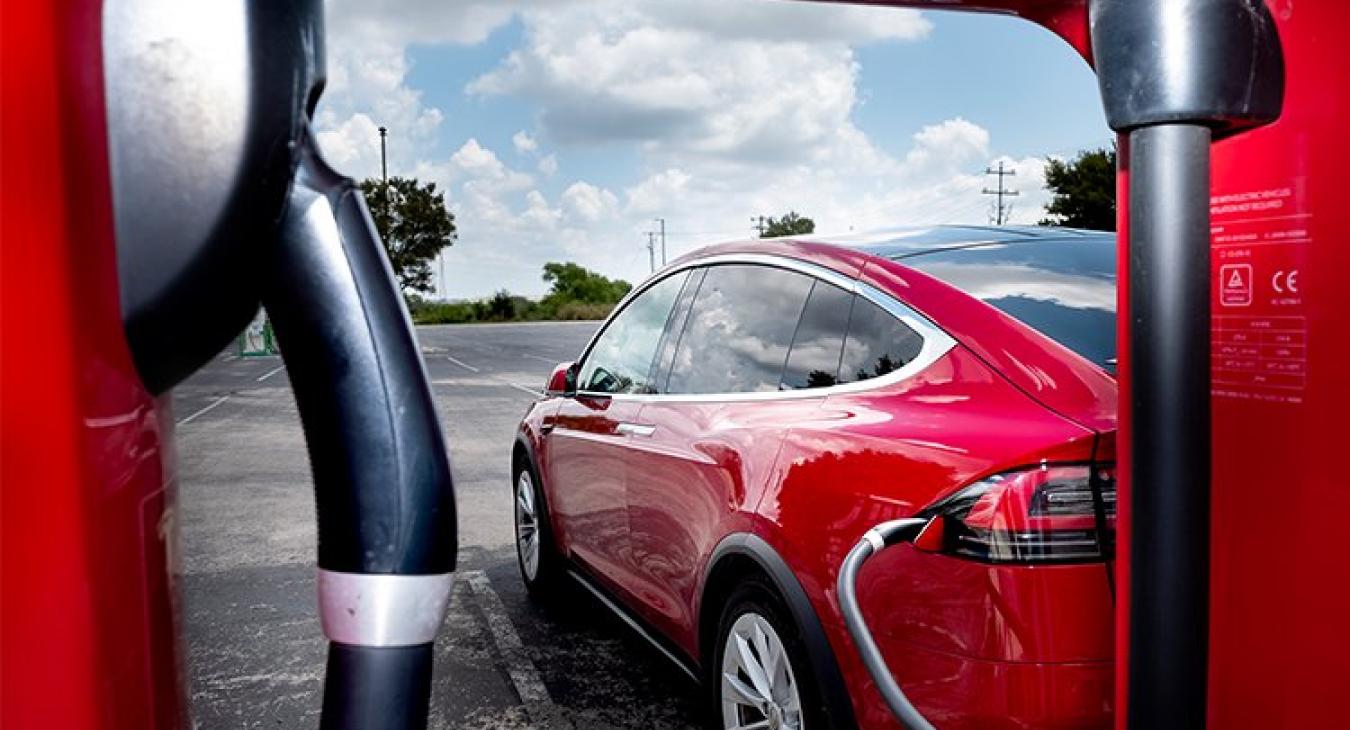A Tesla charges at one of a dozen Tesla Supercharger stations at the San Marcos Premium Outlet mall along Interstate 35. The area also has EVgo and ChargePoint stations, which are both DC fast chargers for other types of electric vehicles. (Laura Skelding photo)
Story by Alyssa Dussetschleger
If you think you're seeing more electric vehicles on the roads of Central Texas, your eyes aren’t lying. By mid-June this year, more than 52,000 electric vehicles — or EVs — were registered in Texas, and 63% of them are model years 2020 or newer, according to data from the Texas Department of Motor Vehicles.
Of the 14 counties where Bluebonnet Electric Cooperative provides power, 10,329 electric vehicles were registered as of August, according to data from the Texas DMV. That’s a fraction of the cars and trucks registered in the area’s counties, but the electric vehicle numbers are going to grow.
One electric vehicle driver’s advice on avoiding ‘range anxiety’»
Teslas are the most popular electric vehicles in counties served by Bluebonnet: 5,179 are registered. Of those, slightly fewer than half are the popular Model 3 sedan, the most affordable Tesla at $39,000. There are another 1,848 Tesla Model Y mid-sized sport utility vehicles, which start at $53,990, on area roads. The least common Tesla (750 are registered) in the region is the high performing S model, a luxury sedan starting at $89,990.
Most popular after the Tesla models is Nissan’s Leaf, a compact car that starts at $27,400. There are 574 of them registered in the region. Next are Chevrolet Bolts, which start at $31,000, with 474 registered in our area.
Plenty of drivers nationwide — 71 percent — say they would consider buying an electric survey by Consumer Reports in 2020. Of course, the massive new Tesla manufacturing facility in eastern Travis County should have new vehicles rolling off the factory floor in a few months, which is certain to raise Central Texans’ Tesla-buying fever.
Two Tesla owners talk
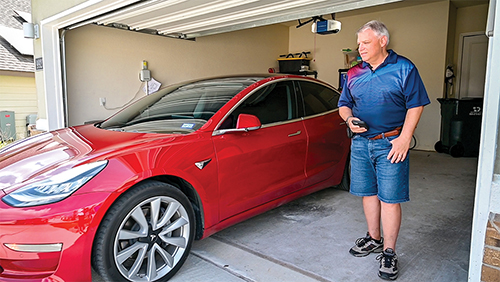
Jeff Nelson was 55 when he bought his first vehicle, an electric Tesla Model 3, in 2018. He got his driver’s license just two years earlier.
The delay was tied to Nelson’s lifelong vision impairment, but that changed in 2015 when he got bioptic lenses, specialized vision-enhancing telescopic lenses that attach to eyeglass lenses. The bioptics can magnify what is seen up to six times, according to the private practice Bioptic Driving USA.
Even though he had his license, before 2018, Nelson didn’t need a car. He lived near his office in Austin and relied on public transportation or his wife to get around.
But three years ago Nelson and his wife, Taffy, moved into a new 2,500-square-foot home in the Whisper Valley subdivision in the Bluebonnet service area.
The development, on FM 973 just east of the Texas 130 toll road, has more than 200 single-family homes and 40 more are under construction. The houses all come with solar panels and other energy-saving options such as geothermal infrastructure, energy-smart appliances and prewiring for garage-mounted electric vehicle chargers.
Nelson did his homework and decided the Model 3 best fit his lifestyle and driving needs. He bought a Tesla wall connector to charge the car in his garage via a 220- volt plug (a standard household outlet is 120 volts) and a 45-inch tall lithium-ion battery to store electricity generated by his solar panels. The slim, rectangular 251-pound Powerwall, also made by Tesla, stores 13.5 kilowatt hours of power for use after the sun goes down or if backup power is needed. Nelson’s wall connector cost $500 and the Powerwall cost $7,500 in 2018.
With his car’s range of 300 miles on a full charge, and Nelson working mostly from home, he only charges his car once a week. His electric bill averages about $40 a month, he estimated.
Deanna Bodine is another Bluebonnet member who drives a 2018 Tesla Model 3.
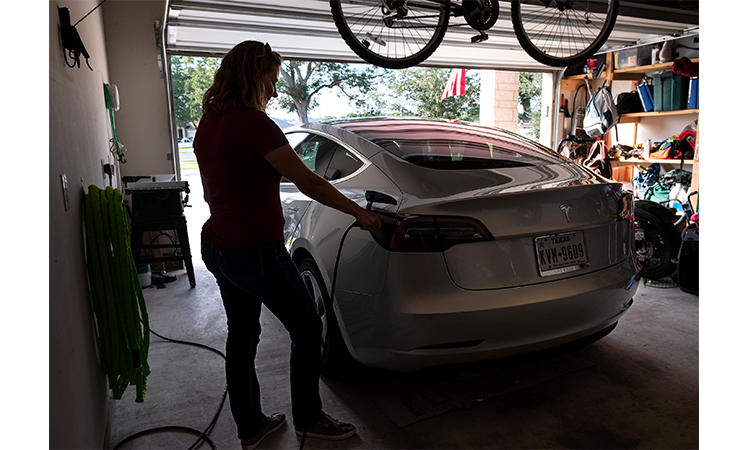
She lives in Bastrop with her husband and five children, and has been a Bastrop County resident and Bluebonnet member since 2001. She teaches music at Emile Elementary School in Bastrop. Before buying the Tesla, she drove a 2011 Kia Sorento. She bought her Model 3 online, she said, and had it delivered to the Tesla service center on Research Boulevard in Austin.
When Bodine moved into her current home in 2019, she equipped her garage with a 240-volt outlet — the type commonly used for electric ovens, dryers or RV plugs — to charge her EV. She usually charges her car at home, daily. Her mobile charger, which came with her car, can charge 21 miles of range in an hour.
Charging her Tesla hasn’t made much of a noticeable impact on Bodine’s electric bill. “Maybe $20 to $30, but I couldn’t tell if it increased due to the heat or charging,” she said.
Bodine has been satisfied with her Tesla and would gladly purchase another electric vehicle. She’s not sure about the make and model, though. “The biggest factor will be nationwide charging ability,” she said.
Get ready for a wave of new electric vehicles
Electric vehicles are rolling past niche status and into the mainstream, and almost every major car manufacturer will offer an electric model in the next few years.
Among those on the list are Toyota, Ford, BMW, Audi, Volkswagen, Hyundai, Honda, Porsche, Kia, Stellantis (which includes Fiat, Chrysler, Jeep and Maserati vehicles), Volvo, Mazda, Mitsubishi, Jaguar, Subaru, Land Rover, Mercedes and General Motors.
As more EVs are made and battery technology gets better, their prices will likely compete with gasoline-fueled vehicles, accordingto the U.S. Department of Energy. Next year’s electric models range from the $29,990 MINI two-door, to the moderately priced $39,990 Kia Niro EV, all the way up to the $150,900 Porsche Taycan Turbo. Volvo has stated that by 2030, it would produce only electric vehicles. General Motors aims to offer 30 different EV models by 2025.

The first full-sized electric pickup from a major manufacturer, the Ford F-150 Lightning, is expected to hit showroom floors in mid-2022. The Lightning, which will start at $39,974 according to Ford’s website, looks similar to Ford’s other F-150 trucks. There are no Ford Lightnings in area showrooms as of this publication’s deadline, but you can reserve one online from your local dealership.
At its Bluebonnet service-area factory, Tesla and its CEO Elon Musk have said the company will make the newest Model 3 sedans, Model Y crossover SUVs and two new vehicles: the futuristic looking Cybertrucks, starting at $39,900, and the big Semi trucks for long-haul commercial drivers, starting at $180,000.
Manufacturers are touting many of the new EVs’ increased ranges (the distance an electric vehicle can drive on a single charge) and affordability. Nissan’s 2022 Ariya, an electric sport-utility vehicle, will retail for about $40,000, according to an estimate from Consumer Reports. The Ariya will have a range of 300 miles on a single charge if the buyer chooses the “long-range battery” option.
U.S. electric vehicle sales could account for 25% to 30% of the new-car market in 2030, and as much as 50% by 2035, according to projections by IHS Markit, a leading global data provider for major industries and markets.
However, EVs’ cost, range and battery longevity (which is typically 100,000 miles in standard electric vehicles today, according to the National Renewable Energy Laboratory) still make plenty of Central Texas drivers pause at the idea of going electric — especially those in rural areas who regularly travel long distances.
It will probably cost less to power an electric vehicle than a gasoline-powered car or truck. The U.S. Department of Energy says that fueling your car with gasoline costs nearly three times as much as fueling a vehicle with electricity. Additionally, the Alternative Fuels Data Center reports electric vehicles have fewer parts and usually do not need as much maintenance as gasoline-powered vehicles. The only maintenance required on Bodine’s Tesla has been “replacing the tires every three years or 40,000 miles, and windshield washer fluid as needed.”
A Chevrolet Bolt’s maintenance schedule includes tire rotation, air filter replacement and draining vehicle coolant circuits at 150,000 miles. Additional maintenance and care may include brakes, heat and radiator hose inspection, lights, windshields and wiper blades.
The most costly repair usually associated with owning an EV is the battery, according to Consumer Reports. The lifespan of an EV battery depends on the model. Chevrolet, for example, provides an eight year or 100,000-mile battery warranty. Tesla high-voltage batteries are under warranty for four years or 50,000 miles. Manufacturers typically do not publish pricing for replacement batteries, but if the battery does need to be replaced outside the warranty, it is expected to be a significant expense according to the Alternative Fuels Data Center.
A major factor in the rush to make electric vehicles in the U.S. is due, in part, to pressure and regulations from the federal and some state governments, according to Daniel Yergin, vice chairman of IHS Markit.
The drive for more electric vehicles faces significant challenges: Electric vehicle manufacturers will have to create entire new supply chains and the vehicles will require new charging infrastructure on a massive scale, he wrote recently.
The biggest challenge, however, will be changing car buyers’ habits: Moving from the familiar to the unknown on such a major investment won’t be easy. But as Texans see more EVs on the road and in the neighbor’s driveway, minds may change. Electric vehicles won’t rule the roads of Central Texas any time soon, but be prepared to make room.
New makes, models of EVs in 2022 and beyond
Automotive News, a weekly newspaper for the automotive industry, estimates that there will be nearly 100 models of electric vehicles available nationwide by the end of 2022. Buyers will see more crossover sport utility vehicles and pickups, from full to mid-size. Many new models will arrive in 2022, with preorders available now. Several automakers have also released plans for vehicles through 2024.
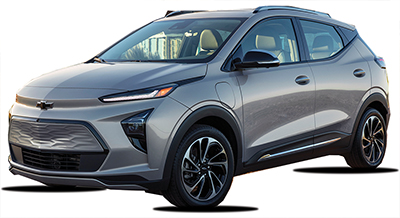
Chevrolet Bolt EUV
Starts at $33,000; Electric SUV, 2022 models in transit to dealers, available for purchase now; 247-mile estimated range; dual-level charge cord with attachment plugs for 120- or 240-volt outlets; hands-free and semi-autonomous driving assistance features; Level 2 charging outlet installed by Chevrolet at home of eligible buyers.
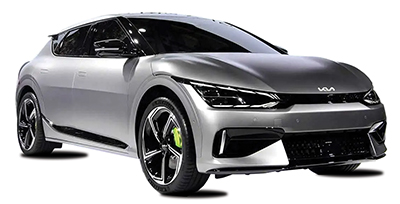
Kia EV6
Starts at $58,500; First edition of new Kia line of crossover EVs, limited number (1,500) being produced, coming January 2022; seats 5, futuristic design with dual curved screens and display, estimated 300- mile range; wait list available.
EVs coming in 2022 and beyond
- 2022 Tesla Cybertruck (manufactured in Travis County)
- 2022 Toyota bZ4X, Toyota’s first electric crossover SUV
- 2023 Subaru Solterra, Subaru’s first electric SUV
- 2023 Jeep Wrangler Magneto
- 2024 Ram 1500 EV, a full-size pickup
- 2024 GMC Hummer
- 2024 Honda Prologue SUV
- 2022 BMW and Mercedes Benz, releasing multiple EVs including small cars such as EQS from Mercedes Benz and SUVs such as the 2022 iX from BMW
Hyundai IONIQ 5
No pricing available; crossover, coming in 2022; estimated 300-mile range (168 kilowatt motor); equipped for “ultra-fast charging” of 60 miles range in 5 minutes; two years unlimited 30-minute free charging on some DC fast chargers in partnership with Electrify America.
Where to charge? Area EV stations
Looking for a place to plug in? PlugShare, a website and app that locates charging
stations, shows more than 30 electric vehicle charging stations in Bluebonnet’s
service area. They include:
Bastrop: Bring your own Level 2 charging cord and connector to Basin RV Resort, 98 Texas 71, 2 miles east of intersection with Texas 21; $10 per charging session.
Brenham: One Level 2 charging station with two charging cords at City Hall, 200 W. Vulcan St.; Level 2 charging stations at Coach Light Inn, 2242 S. Market St., free and open to public; chargers at Holiday Inn Express, 2685 Schulte Blvd. and at Best Western Inn, 1503 U.S. 290 E. for hotel guests’ use.
Caldwell: One Level 2 charging station at Bud Cross Ford, 150 Texas 36 at U.S. 21 intersection, free and open to public 8 a.m.-5 p.m., Monday-Friday; 9 a.m.-1 p.m. Saturday.
Cedar Creek: Four Level 2 chargers for resort guests at Hyatt Regency Lost Pines Resort and Spa, 575 Hyatt Lost Pines Road (off Texas 71 W.); chargers installed through partnership with Bluebonnet Electric Cooperative.
Elgin: Two Level 2 chargers at Austin Community College campus, 1501 U.S. 290, 2 miles west of intersection with U.S. 95; $4-$12 per charging session, based on time.
Giddings: 8 Tesla Superchargers at CEFCO Travel Center, 3025 W. Austin St. (which is also U.S. 290) 2 miles east of intersection with U.S. 77; payment required based on usage, charging time up to 30 minutes.
Manor: Two Level 2 Tesla chargers and 1 standard EV Level 2 charger (J-1772 connection) at Whisper Valley subdivision, 9400 Petrichor Blvd, at the Amenity and Discovery Center, free to the public; one Level 2 charger, free for residents of The Flats at Shadowglen apartment complex, 12500 Shadowglen Trace.
New Ulm: Two Level 2 chargers for visitors and the public at The Vine wedding and event venue, 25642 Bernard Road, 8 miles south of Industry.
San Marcos: 12 Tesla Superchargers at San Marcos Premium Outlets, 3939 S. I-35, payment required based on usage.
Charging 101: Powering an electric vehicle
Chargers vary in type, voltage, connector type, speed at which they charge and what vehicles they can charge.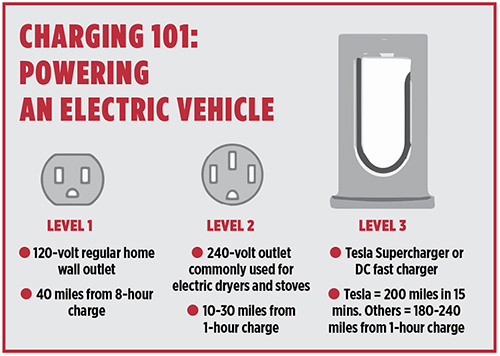 There are three levels of chargers: AC Level 1, AC Level 2 and DC Level 3 fast chargers (or Superchargers for Teslas).
There are three levels of chargers: AC Level 1, AC Level 2 and DC Level 3 fast chargers (or Superchargers for Teslas).
Level 1 is the simplest and slowest. A specialized adapter plugs the car into a standard 120-volt outlet. (Standard household outlets are 120 volts.) That will give the car about 3-5 miles of driving range per hour of charging — very slow.
Most EV owners use Level 2 AC chargers at home or on the road. The Level 2 runs off a 240-volt outlet, the same type used to power most clothes dryers. It can power an electric vehicle three to seven times faster than the Level 1 charger – about 10-30 miles of range every hour. A Bluebonnet Electric Cooperative member would pay $3.44 to give a 2021 Nissan Leaf enough power to drive 149 miles.
A new 240-volt outlet and wall charger should be installed by a certified electrician or installer.
If you’re looking for more juice, public charging stations are often equipped with powerful Level 3 chargers. A Tesla Supercharger, only for Teslas, can charge a Model 3 with 200 miles of range in 15 minutes. For most other electric vehicles, a Level 3 DC fast charger can provide 180 to 240 miles of range per hour of charging. Not every electric vehicle model can charge at Level 3, so check vehicle specifications.
Unless you drive a Tesla, there are two types of connectors for DC fast chargers, and they are not interchangeable between vehicle models. Make sure you know which type you have or need.
Public charging, especially Level 3, often isn’t free. Drivers may pay by the minute or by how much electricity they use. Prices can vary based on electricity cost and charging level.
Sources: epa.gov, energy.gov, Alternative Fuels Data Center (afdc.energy.gov), fueleconomy.gov, consumerreports.org, Kelley Blue Book (kbb.com), tesla.com, myev.com
There's an app for that (finding a charging station)
Most new electric vehicle models, including the Ford F-150 Lightning, Chevrolet Bolt EUV and Hyundai Kona, will have charging maps built into their navigation systems. But many electric vehicle owners opt for smartphone apps to help plan their routes, especially for longer trips.
PlugShare — Filter for your plug and charging level type, and exclude chargers currently in use; on its website, find amenities at charging stations such as restrooms
ChargePoint — Find stations, check charger availability, get updates about your vehicle’s charge status and range; at ChargePoint charging stations, app unlocks chargers for real-time charging updates; app also synchs with Apple and Google maps to find nearest available charger
ChargeHub EV Map — Trip planner will find charging locations on your route; create a user profile, check in to a station, leave comments and pictures to help other users select a station
Google Maps — Added EV charging stations to map features in 2011; search “charging stations” to find one nearby; see how many chargers are available, their type and power capabilities
Chargemap — Search a city or ZIP code using app or website to get charging station details, addresses and hours, amenities, charger types; apply filters to find correct power level and necessary connector; app also includes route-planning tool and user reviews of charging stations.
How do you buy a Tesla in Texas?
You cannot go to a dealer in Texas to buy a Tesla because Tesla doesn’t have dealerships in Texas — or anywhere else.
Texas law requires automotive manufacturers to sell their vehicles to independently owned third-party businesses such as dealerships, which then sell to individuals. One exception: used Teslas obtained through trade-ins can be sold by dealers.
Texans who want to buy a Tesla must either buy it online from tesla.com or in another state; then it must be delivered by Tesla to a regional Tesla service center for pick up. The vehicle will have out-of-state registration, and new owners have 30 days to register their Tesla in Texas, according to the Texas Department of Motor Vehicles.
Texas has 12 Tesla service centers. Those nearest the Bluebonnet Electric Cooperative region are in Austin (12845 Research Blvd. in North Austin), two in Houston (9633 Westheimer Road and 14820 North Freeway in North Houston) and in San Antonio (23011 I-10 W).
At tesla.com, you can buy new or used vehicles for an order fee ranging from $100 to $500. Buyers create a Tesla account and go through a step-by-step process of “delivery tasks,” which include submitting the final payment, financing and/or trade-in documentation. You’ll also receive the vehicle’s VIN and schedule delivery to a Tesla service center.
The waiting time for your Tesla varies with financing and model availability. The estimated delivery of new cars, at our time of publication, is January 2022 for a Model Y or Model 3, February 2022 for a Model S and April 2022 for a Model X. In early September 2021, there were many used car options on Tesla’s website.
Once your Tesla arrives at the service center, a technician will show you how to operate and navigate it. More information is at tesla.com/support/ordering.
Sources: statesman.com, capitol.texas.gov, businessinsider.com, tesla.com/support/ordering
Download this story as it appeared in the Texas Co-op Power magazine »





